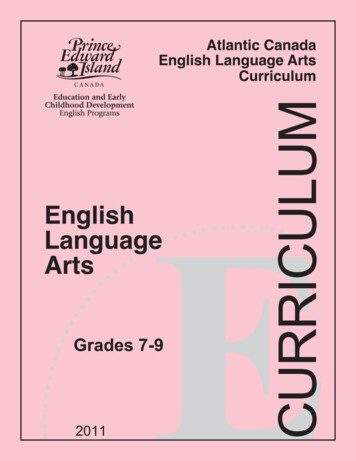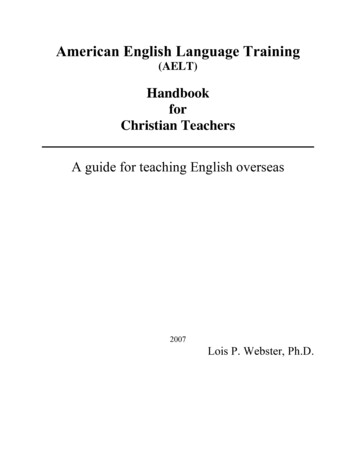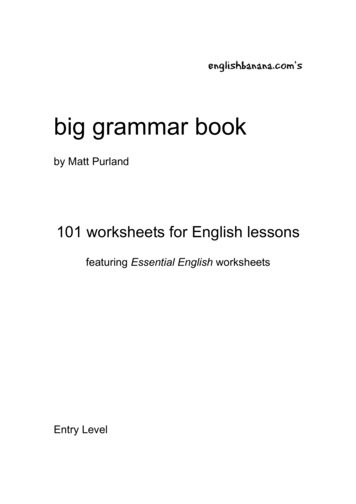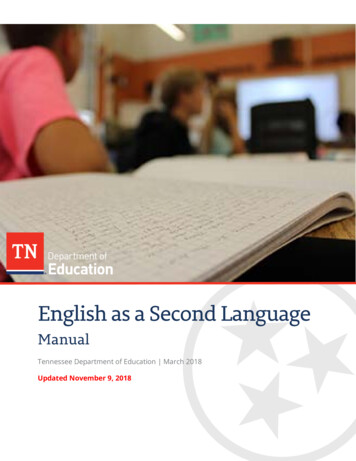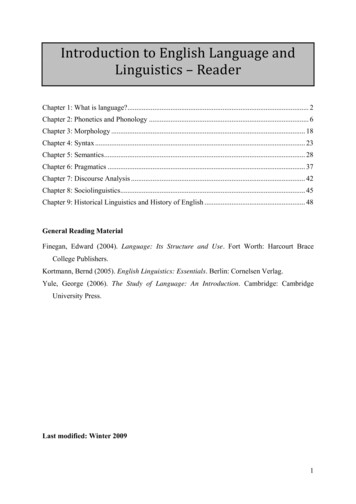
Transcription
Introduction to English Language andLinguistics – ReaderChapter 1: What is language?. 2Chapter 2: Phonetics and Phonology . 6Chapter 3: Morphology . 18Chapter 4: Syntax . 23Chapter 5: Semantics . 28Chapter 6: Pragmatics . 37Chapter 7: Discourse Analysis . 42Chapter 8: Sociolinguistics. 45Chapter 9: Historical Linguistics and History of English . 48General Reading MaterialFinegan, Edward (2004). Language: Its Structure and Use. Fort Worth: Harcourt BraceCollege Publishers.Kortmann, Bernd (2005). English Linguistics: Essentials. Berlin: Cornelsen Verlag.Yule, George (2006). The Study of Language: An Introduction. Cambridge: CambridgeUniversity Press.Last modified: Winter 20091
Chapter 1: What is language?by Susan DostertThe term ‘language’ can be used to refer to a variety of concepts / things, such as “theparticular form of words and speech used by the people of a country, area or social group”, or“the method of human communication using spoken or written words”. In other words, wecan talk about a specific language e.g. English, German, Swahili etc. or about language assuch. In linguistics, we are interested in both of these fields, whereby General Linguistics willtend to concentrate on the latter topic and the individual language departments on theirspecific language e.g. English linguistics. A further meaning of ‘language’ is “the style ortypes of words used by a person or group”, which is a topic generally studied withinsociolinguistics.Language as a form of human communicationMost linguists would probably agree that although many animals are able to communicate,they do not actually have ‘language’ in the sense that humans do. Birds may sing, cats miaowand purr, dogs bark and growl, apes grunt, scream and even chatter, but they are not assumedto be using these sounds in the way we do. ‘Language’ is therefore a major attributedistinguishing us from the rest of the animal kingdom.Yule’s 5 characteristics of human languageDisplacementThis is the ability to use language to talk about times, places and people other than the ‘hereand now’. It also enables us to say things which we know to be false i.e. to lie. Bees are saidto be able to convey some of this information in their ‘dance’ which they employ to pass oninformation about food sources.ArbitrarinessThis means that there is generally no natural, inherent relationship between the signs (i.e.sounds or letters) we produce and their meaning. For this reason different languages can usedifferent signs to refer to one and the same thing e.g. a flower in English is a Blume inGerman or a fleur in French. Occasionally we find examples of iconicity, where someone hastried to overtly create a resemblance between the sign and its meaning.Examples:smalltallfatWhen language tries to mirror or ‘echo’ the sounds made by animals and objects this is calledonomatop(o)eia.Examples:cuckoo2
squelchticktockArbitrariness also enables languages to evolve, both in the sense that existing signs can cometo mean new things (e.g. pen which used to refer to a quill), but also that new signs can beintroduced for existing things. Animal languages, in contrast, are more likely to have fixedreference i.e. a certain sign has a specific and fixed meaning.ProductivityThis is an important characteristic of human language allowing us to continuously create newutterances, combining the ‘building bricks’ of language in ever new ways, whether these besounds, words or sentences. Human languages are therefore continually evolving.Cultural TransmissionThis refers to how languages are acquired by our children. The assumption is that there is nogenetic component (although Noam Chomsky challenges this with his theory of UniversalGrammar) which would enable a child to simply start speaking e.g. English at a certain age,but rather that children need to be exposed to a language (and culture) in order to acquire it.This means, for example, that a child born in Korea to Korean parents but then adopted byFrench parents in France will tend to grow up speaking French as his/her first language andnot Korean (unless the French parents make sure the child is also exposed to Korean). Manyanimals, however, do seem to pass the ability to communicate on to their offspring geneticallye.g. dogs will bark even if they have never heard another dog.DualityDuality (or ‘double articulation’) refers to two separate layers of language working togetherto provide us with a pool of sounds which we can combine to communicate with one another.On the one hand, we have a limited number of discrete sounds (e.g. the 44 phonemes inEnglish) which in isolation have no inherent meaning e.g. b, i, or n. On the other hand, wehave a virtually unlimited number of distinct meanings which we can create by combiningthese sounds in certain ways e.g. bin, or nib. Various other combinations such as *bni are notmeaningful in English, but could possibly be in other languages.Other features of human languageA further feature of human language is reflexiveness, which means that we are able to use thelanguage to talk about language – which is typically what linguists do. Discreteness is alsosomething that is said to distinguish human languages from other forms of animalcommunication. It means that the sounds of a language differ sufficiently from one anotherfor a (native) speaker to distinguish them and thereby know which sign with which meaning isbeing used at any one time.Language and the brainLanguage is a cognitive skill and one therefore whose roots are situated in the evolution of thebrain. We do not know exactly when our ancestors began to speak (estimates vary from30,000 – 100,000 years ago), or even what triggered them to do so, but once they started,3
there was no stopping them. From such humble beginnings the 5,000 – 6,000 languages weassume to exist today have evolved.Research mainly on language aphasia has been able to show that there are two major areas ofthe brain specialised in language processing, production and comprehension: Broca’s andWernicke’s areas, situated in the left hemisphere and named after the two physicians whofirst discovered them in the 19th century.What is linguistics?Linguistics is the science of language(s). It is generally a descriptive discipline rather than aprescriptive one, which means that linguists do not lay down hard and fast rules about how touse a certain language, but rather concentrate on describing the rules which (especially native)speakers seem to have internalised. Apart from this, there are various different ways of‘doing’ linguistics. For example, we can concentrate on language as used at a certain point oftime e.g. in 1989; this is called synchronic linguistics. Alternatively, we can look at languagefrom a diachronic point of view, which involves analysing the development of a languageduring a certain period of time e.g. during Middle English, or in the 1950s etc. Linguistics is ascience which can either be studied in a theoretical or a more applied way. For example,someone may be interested in finding out exactly how questions are formed in English ( theoretical). Once this is known the knowledge could be applied e.g. to language teaching,thereby (hopefully) enabling teachers and pupils to learn the language more effectively.ReadingYule, George (2006). The Study of Language: An Introduction. Cambridge: CambridgeUniversity Press. Ch. 1-2Kortmann, Bernd (2005). English Linguistics: Essentials. Berlin: Cornelsen Verlag. Ch. 1.Finegan, Edward (2004). Language: Its Structure and Use. Fort Worth: Harcourt BraceCollege Publishers. Ch. 1.Advanced readingBauer, Laurie & Trudgill, Peter (Eds.). (1998). Language Myths. London: Penguin.4
Herrmann, Christoph & Fiebach, Christian (2004). Gehirn & Sprache. Frankfurt a. M.:Fischer.Pinker, Steven (1994). The Language Instinct. London: Penguin.5
Chapter 2: Phonetics and Phonologyby Heidrun DorgelohThe two primary linguistic disciplines concerned with speech sounds - those sounds that areused by humans to communicate - are phonetics and phonology. Both areas are mutuallydependent. Phonetics describes the concrete, physical form of sounds (how they areproduced, heard and how they can be described), while phonology is concerned with thefunction of sounds, that is with their status and inventory in any given language.Phones and PhoneticsThe two basic tasks of phonetics are the transcription and the classification of sounds, alsocalled phones in this context. The phone is therefore the basic unit of phonetics and it refersto the concrete sound substance as such. In the area of articulatory phonetics this substanceis described on the basis of the articulatory properties. These refer to the human vocal tract(or to the speech organs), illustrated below, and are used to describe and classify sounds. Bycontrast, acoustic and auditory phonetics deal with the characteristics of sound waves andhow they are perceived by the human ear.Phones are represented by placing brackets around the transcription ([da:ns]/[dæns] for dancein British and American English)). The usefulness of a transcription system (a phoneticalphabet) is particularly plausible in a language such as English, where pronounciation andand spelling often diverge substantially (cp. see – sea on the one hand, and through andthough, on the other). There are various transcription models, such as the IPA (InternationalPhonetic Alphabet); for the transcription of English, several, slightly differing systems haveevolved, all of them following in some way the original model of the phonetician DanielJones.6
Classification of soundsTraditionally, sounds are classified into consonants and vowels. Consonants are sounds thatare produced with a major obstruction in the mouth cavity. For example, in the case of [t](Fig. 1), there is direct contact between the tip of the tongue (active articulator) and thealveolar ridge (passive articulator), so that the airflow coming from the lungs can leave themouth cavity only when the obstruction is removed:Fig. 1. consonant [t]Vowels are sounds that are produced without such obstruction. For example, in the case of [i:](Fig. 2), there is a gap within the mouth that is determined by the position of the tongue, andthe airflow can escape relatively freely:Fig. 2. vowel [i:]Another difference between consonants and vowels is that vowels are generally voiced, i.e.the vocal cords are set vibrating by the outgoing airflow. Consonants, by contrast, can bevoiced or voiceless: The vocal cords are either far apart and do not vibrate, as in fan, or theyare relatively closed and vibrate as in van (Fig. 3).7
Fig. 3. Voiceless and voiced soundsClassification of consonantsFactors relevant for the classification of consonants include the manner of articulation, theplace of articulation, and voicing. With regard to the manner of articulation, Englishconsonants can be classified into plosives, fricatives, affricates, nasals, liquids, and semivowels.Plosives are consonants that are made up by completely blocking the airflow. The productionof plosives involves three stages: 1) a direct contact between the active and the passivearticulator forming a complete obstruction to the airflow; 2) the compression of air behind theobstruction; and 3) the release of the compressed air in the form of an “explosion” (hence theterm plosive). There are six plosives in English: bilabial [p] and [b], alveolar [t] and [d], andvelar [k] and [g].Bilabial plosives [p] and [b] are produced with both lips pressed together. The activearticulator is the lower lip; the passive articulator is the upper lip. The soft palate is raised andthe air coming into the mouth stops for some time and then breaks the obstruction with aslight explosion. In the case of [b], the vocal cords are vibrating:Fig. 4. bilabial plosives [p] and [b]Alveolar plosives [t] and [d] are produced with the tip of the tongue firmly pressed againstthe (middle part of the) alveolar ridge. The active articulator is the tip of the tongue; thepassive articulator is the alveolar ridge. The tip of the tongue makes firm contact with the8
alveolar ridge. The air is trapped for a short time and then breaks the obstruction with a slightexplosion. In the case of [d], the vocal cords are vibrating:Fig. 5. alveolar plosives [t] and [d]Velar plosives [k] and [g] are articulated with the back of the tongue against the soft palate.The active articulator is the back of the tongue; the passive articulator is the soft palate. Theback of the tongue makes firm contact with the soft palate. The air is trapped for a short timeand then breaks the obstruction with a slight explosion. In the case of [g], the vocal cords arevibrating:Fig. 6. velar plosives [k] and [g]Fricatives are consonants that are produced by impeding, but not completely blocking theairflow, i.e., there is a narrow gap between the active and the passive articulator along whichthe airflow can leave the oral cavity. There are nine fricatives in English: labio-dental [f] and[v], interdental [θ] and [ð], alveolar [s] and [z], palate-alveolar [ʃ] and [ʒ], and glottal [h].9
Fig. 7. labio-dental fricatives [f] and [v]The lower lip is very close to the edge of the upper front teeth, thus forming an incompleteobstruction. When the air goes through the narrowing it causes slight friction (hence the termfricative). For [f] the vocal cords do not vibrate; there may be some vibration accompanying[v] when it occurs in word initial position as in e.g. vast or between vowels as in e.g. never.Fig. 8. interdental fricatives [θ] and [ð]The tip of the tongue is either close to the edge of the upper teeth or slightly projectedbetween the teeth. For [θ] the friction is as strong as for [f], for [ð] it is gentler. For [θ] thevocal cords do not vibrate; they vibrate for [ð] when it occurs in word initial position, before avowel or in intervocalic positions. E.g. that, rather, etc.Other fricatives are produced with different places of articulation: For the alveolar fricatives[s] and [z], the tip of the tongue is close to the alveolar ridge. The teeth are very closetogether. The friction for [s] is strong, even stronger than for [θ]. For [s] the vocal cords donot vibrate; they vibrate for [z] when it occurs before vowels or in intervocalic positions. E.g.zone, easy, etc.10
Fig. 9. alveolar and palate-alveolar fricatives [s], [z], [ʃ] and [ʒ]For [ʃ] and [ʒ], the tip of the tongue is close to the back part of the alveolar ridge forming aflat narrowing. The front part of the tongue is raised towards the hard palate forming the frontsecondary focus. The friction for [ʃ] is strong, stronger than for [f] and [θ]. For [ʃ] the vocalcords do not vibrate; they vibrate for [ʒ] when it occurs before vowels. E.g. pleasure, etc.Fig. 10. glottal fricative [h]It is produced with the voiceless expulsion of air from the lungs with the mouth and tonguealready in position for the following vowel.Affricates are sounds that are similar to both plosives and fricatives: The tip of the tonguetouches the back part of the teeth ridge, the front part of the tongue is raised towards the hardpalate. The air is trapped for a short time because of a complete obstruction between the tip ofthe tongue and the teeth ridge, then the obstruction is released slowly and the friction is heard.The voiceless affricate is [tʃ] as in chain, whereas [dʒ], as in jelly, is voiced.Nasals are consonants which, like plosives, are produced by completely blocking theairstream. But there is an important difference: The airflow escapes through the nasal cavity(hence the term nasals). There are three nasal consonants in English: bilabial [m], alveolar[n], and velar [ŋ]:11
Fig. 11. bilabial nasal [m]The lips are firmly kept together forming the complete obstruction. The active articulator isthe lower lip; the passive articulator is the upper lip. The soft palate is lowered and the airescapes through the nasal cavity. The vocal cords are vibrating.Fig. 12. alveolar nasal [n]The tip of the tongue is pressed against the alveolar ridge forming the complete obstruction.The active articulator is the tip of the tongue, and the passive articulator is the alveolar ridge.The soft palate is lowered and the air escapes through the nasal cavity. The vocal cords arevibrating.Fig. 13. velar nasal [ŋ]The back of the tongue is pressed to the soft palate forming the complete obstruction. Theactive articulator is the back of the tongue, and the passive articulator is the soft palate. The12
soft palate is lowered and the air escapes through the nasal cavity. The vocal cords arevibrating.Liquids include alveolar [l] and post-alveolar [r].Fig. 14. alveolar [l]The tip of the tongue is in firm contact with the alveolar ridge forming the completeobstruction. The active articulator is the tip of the tongue, and the passive articulator is thealveolar ridge. The sides of the tongue are lowered and the air can pass between them. Thevocal cords are brought together and are vibrating.Fig. 15. post-alveolar [r]The tip of the tongue is held in a position near to but not touching the back part of the alveolarridge. The soft palate is raised and the air flows quietly between the tip of the tongue and thehard palate. The front part of the tongue is low and the back is rather high so that the tonguehas a curved shape. The vocal cords are vibrating.Semi-glides or glides include bilabial [w] and palatal [j]: [w], as in why, starts out with thelips firmly rounded, these articulators then moving away ( gliding) from the narrowing in themouth. When articulating [j], as in you, the front part of the tongue is first raised towards thehard palate, then the soft palate is raised and the air goes along the central part of the tongue.The vocal cords are kept together and are vibrating.The reason why these sounds are called semi-vowels is thus their manner of articulation: Liketrue vowels, semi-vowels are produced without a major obstruction, i.e., there is a wide gapbetween the active and the passive articulator, so that the airflow can escape relatively freely13
from the mouth. However, unlike true vowels, semi-vowels never form the nucleus of asyllable (e.g., week, yellow) and are therefore usually considered consonants.Classification of vowelsDepending on the height of the tongue, vowels can be classified into high, low, and midvowels:1) When the front or the back of the tongue is raised towards the roof of the mouth, the vowelis called high, this is the case, e.g., in pill, meet, look, or soon.2) When the front or the back of the tongue is as low as possible, the vowel is called low, as,e.g., in land, star, or dog.3) When the tongue occupies the position intermediate between the high and the low one, thevowel is called mid, e.g. in get, or the unstressed [ə] in about.Depending on the part of the tongue that is raised most vowels are classified into front, back,and central vowels:1) When the front part of the tongue is raised towards the hard palate, the vowel is calledfront, e.g. in meet, get, or land.2) When the back part of the tongue is raised towards the soft palate, the vowel is called back,as in star, dog, law, or soon.3) When the front part of the tongue is raised towards the back part of the hard palate, thevowel is called central, e.g. in about, much, or nurse.These high-low and front-back dimensions of vowel articulation are also referred to as vowelquality. To illustrate how the articulatory properties of vowels relate to each other, a vowelchart is commonly used as a reference system. The chart below (adapted from Kortmann(2006: 68)) describes the basic vowel qualities of most standard varieties of English togetherwith their phonetic transcription.As can be seen from this chart, some vowels do not only differ qualitatively, but alsoquantitatively (as indicated by the colon as the diacritic for length). Long as opposed toshort vowels also differ by being tense as opposed to lax:1) Tense vowels are produced with a deliberate, accurate, maximally distinct gesture thatinvolves considerable muscular effort. Tense vowels are either long vowels (e.g. [i:] in meet)or diphthongs (e.g. [eI] in say).14
2) Non-tense (or lax) vowels are produced rapidly and are therefore short (e.g. [I] in pill).DiphthongsThe vowels described so far have all been monophthongs, in contrast to the diphthongs (orgliding vowels), where the tongue moves from one position to another. Examples can befound in day, fight, oil, so, and now for the so-called closing diphthongs, while centringdiphthongs occur, for example, in bare, beer, and sure.Phonemes and phonologyPhonemes, in contrast to phones, are defined by their function within the language system(langue). This function is basically one of meaning differentiation, although other functionsof phonic means, such as an expressive function of vowel lengthening (That was coooooool),are also possible. All sounds, however, which have a meaning-differentiating function withina given language are considered phonemes within that language system; these are abstract,idealized units within our minds or parts of our model of a language that we design; inlanguage use (parole) phonemes are always realized as phones.The test for these smallest distinctive units of a given language system is the minimal pairtest, i.e. when a difference in sound structure also causes a shift in meaning. An example is [k]in cable and [t] in table, which therefore constitute phonemes of English, indicated by thenotation /k/ and /t/. Note, however, that we are dealing with the actual sound structure here,not with spelling, so tea/he are a minimal pair, while see/sea are not. Also, minimal pairs areonly pairings that differ in exactly one segment; so, pin and tin, or tin and ten, are minimalpairs, while pin and ten would be not.AllophonesSome sound differences do not differentiate meaning, as in the pronunciation of /l/ in thewords lip and pill. While the difference may be only slight (you may try to keep track ofwhere you place the tip of your tongue), from a phonetic point of view the two realizations of/l/ have to be considered two phones, but not two phonemes. They are called clear and dark/l/ and are two allophones of the phoneme /l/ in English.Distribution of allophonesIn contrast to phonemes, allophones do not occur in minimal pairs, which means they eithernever occur in the same environment (complementary distribution), as in the case of clearand dark /l/, or they occur in free variation. For example, voiceless plosives at the end of asyllable or word are sometimes aspirated (if deep is pronounced [di:ph]), but they may just aswell not be (if deep is pronounced [di:p]). The decisive difference between phonemes andtheir allophones is that the variants of a phoneme do not differentiate meaning, and thereforethe sound difference does not constitute a relevant phonetic feature.Phonological systemsThe phonology of a language is also the inventory of its phonemes, i.e. the sum of all thosesounds that show distinctive (i.e. meaning-differentiating) phonetic differences. RP as thestandard (British) English sound system, for example, has-24 consonants,15
-12 vowels, and8 diphthongsbut it has many more allophones (such as clear and dark /l/, or the aspirated plosives). Bycontrast, this table shows the phoneme inventory of Standard Mandarin, the official languageof China: As can be seen, one major difference to English is that Standard Mandarin lacks thevoiced bilabial, alveolar and velar plosives /b/, /d/ and /g/, while it has the aspirated versionsof the consonants pʰ, tʰ, kʰ as distinct phonemes. In other words, a difference (aspiration) thatdoes not distinguish meaning in English and is thus a redundant articulatory featureconstitutes a distinctive feature in Mandarin Chinese, while another one (the voicing ofplosives) is distinctive in English (i.e. it distinguishes meaning), but not in Chinese.SyllablesPhonology does not only describe a system of sounds in isolation, but it also deals with therules and restrictions that hold for their combinations. This branch of phonology is calledphonotactics. Phones combine into the syllable, which is essentially a vowel with optionalconsonants clustered around it. The vowel forms the nucleus of a syllable, with the onset infront of it and the coda behind it. Depending on whether there is a coda or not, a syllable canbe described as either closed or open. The basic form of the English syllable is (CCC) V(CCCC), i.e. I, spray, or texts are all examples of one syllable but of different complexity.ProsodyProsody belongs to the domain of suprasegmental phonology in that it describes phenomenaextending over more than one phoneme. The phenomena that belong here are stress, rhythm,and intonation. While stress can be word or sentence stress, rhythm and intonation occur inphrases and sentences. Intonation is described by reference to pitch (tones); different levelsof pitch are used to express a wide range of meanings: for example, we use the differencebetween a falling and a rising pitch pattern in statements and questions.Connected SpeechThe phonological changes that occur when language is used in natural utterances aredescribed as features of connected speech. The most important ones are:-assimilation, i.e. when neighbouring sounds become more alike (as in im-possible, incontrast to in-decent)elision, i.e. the loss of sounds (as in Chris(t)mas or san(d)wich)intrusion and linking (as in law(r) and order).The most important feature of connected speech, however, is the occurrence of weak forms,which is the result of the occurrence of stress in connected speech. English has the property ofbeing a stress-timed language, which means there is a tendency for stressed syllables to occurat fairly equal intervals. As a result, in unstressed syllables vowel quality tends to beweakened, mostly to the schwa [ə], but the total omission of vowels (as it frequently happensin contractions, such as isn’t, she’s) is also possible, particularly in the case of functionwords (auxiliaries, pronouns, prepositions, conjunctions).16
References (for some of the more technical descriptions):Cruttenden, Alan 2008. Gimson's pronunciation of English. Seventh Edition. London: HodderArnold Publication.Sokolova, M.A. et al 1997. Prakticheskaya fonetika anglijskogo jazyka [English practicalphonetics]. Moskva: VladosReading:Finegan, Edward (2004). Language: Its Structure and Use. Fort Worth: Harcourt BraceCollege Publishers. Ch. 3 4.Kortmann, Bernd (2005). English Linguistics: Essentials. Berlin: Cornelsen Verlag. Ch. 2.Yule, George (2006). The Study of Language: An Introduction. Cambridge: CambridgeUniversity Press. Ch. 4.Advanced Reading:Giegerich, Heinz J. (1995). English Phonology. Cambridge: Cambridge University Press.MacMahon, April (2006). An introduction to English phonology. Edinburgh: EdinburghUniversity Press.Phonetics: The Sounds of English and Spanish. The Phonetics Flash Animation Projectprovided by the University of Iowa. http://www.uiowa.edu/ acadtech/phonetics(Accessed: 15/02/2010)17
Chapter 3: Morphologyby Susan DostertMorphology comes from a Greek word meaning ‘shape’ or ‘form’ and is used in linguistics todenote the study of words, both with regard to their internal structure and their combination orformation to form new or larger units.Words‘Word’ is a term in common everyday use but one which linguists cannot easily define. Isisn’t for example one word or two? And how about mother-in-law? It denotes one concept butis formed out of three recognisable ‘words’: mother, in and law. Linguists therefore preferother terms, referring to morphs, morphemes and lexemes when talking about ‘words’.Morpheme typesMorphemes are defined as the smallest meaning-bearing units in language. These are abstractunits, realised in actual language by a morph, or if there are various ways of realising onemorpheme by its allomorphs. If morphemes are free they will coincide with what we call aword, but morphemes can also be bound in which case they are less than a word (althoughthey carry meaning). The free morphemes are generally also referred to as lexemes, and thebound ones as affixes. (Note that lexemes can be simple i.e. consisting of just one freemorpheme or complex consisting of 2 or more morphemes of which at least one is free.)Affixes which come in front of a free morpheme are prefixes, and those which come after aresuffixes.Example:treestree is an example of a free morpheme as it can stand on its own and has a lexical meaning. -son the other hand is simply a letter (technical term: graph) / sound (technical term: phone)which turns the lexeme tree into a plural. It is a separate morpheme as it contributes(grammatical) meaning to the whole: trees. The -s cannot stand on its own and is therefore abound morpheme, a suffix.Some special sub-types of morph are the cranberry or unique morph, which only occurs inone lexeme in a particular language, the zero morph, which has a meaning / function but noform, and the portmanteau morph,
In linguistics, we are interested in both of these fields, whereby General Linguistics will tend to concentrate on the latter topic and the individual language departments on their specific language e.g. English linguistics





